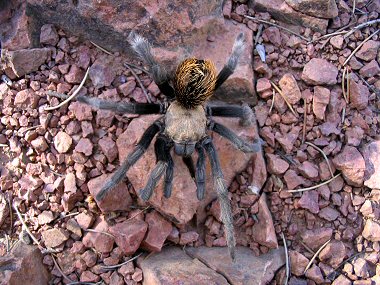Tarantulas spend most of their time
underground in burrows (a tarantula burrow can be identified as a 1-2
inch hole covered with some fine strands of silk). In the winter they
 plug
the opening with rocks and silk and remain in a relatively inactive
state, living off their body reserves. Except in the mating season,
tarantulas remain close to their burrows, and prefer to hunt at night.
To eat, they grab and inject their prey with venom which paralyzes them
and begins the process of digestion. plug
the opening with rocks and silk and remain in a relatively inactive
state, living off their body reserves. Except in the mating season,
tarantulas remain close to their burrows, and prefer to hunt at night.
To eat, they grab and inject their prey with venom which paralyzes them
and begins the process of digestion.
|
The photo at right is of a female
Arizona Blond Tarantula. |
Tarantulas are not dangerous to humans, though they
can deliver a painful bite if provoked. In addition to venom, tarantulas
are equipped with barbed hairs on the top of their abdomen. When
threatened, it can brush these hairs onto it's attacker. These hairs are
irritating, and because of the barbs, are difficult to remove.
The spiders typically mature around 10-12 years of age and can live up
to 20 years. Once mature, a male will leave his burrow in search of a
mate (the tarantulas you see on the roads in Arizona are usually males
cruising for females). Upon finding the burrow of a female spider, the
male will announce himself by tapping and plucking the silk at the
entrance. After mating, the male beats a hasty retreat lest the female
kill and eat him, though even if successful, he usually does not survive
much longer. |

